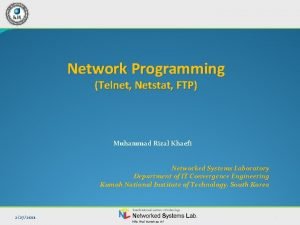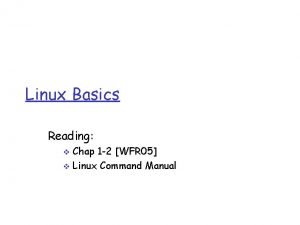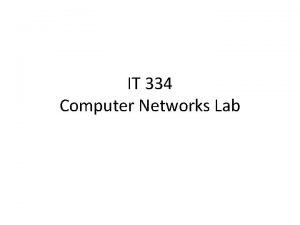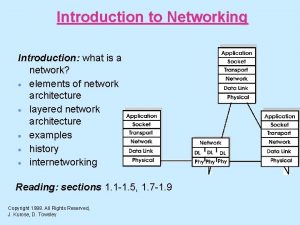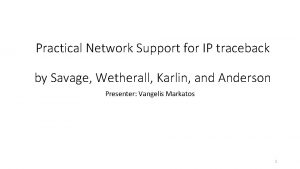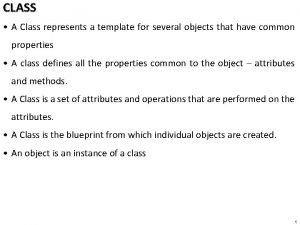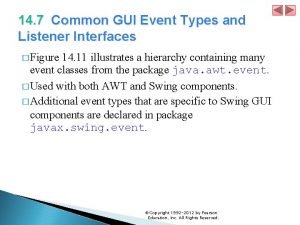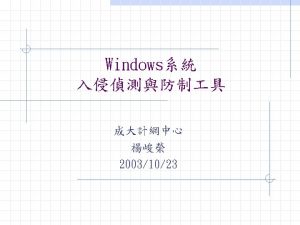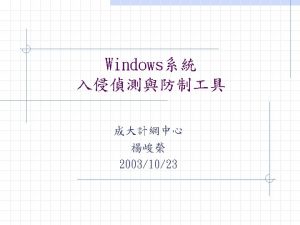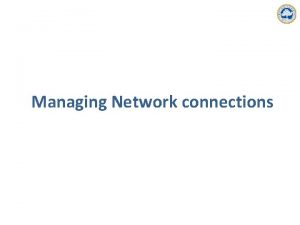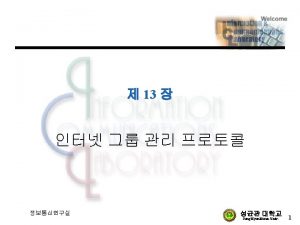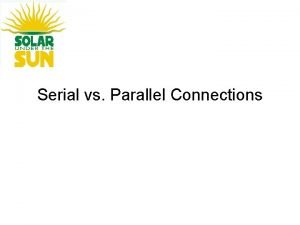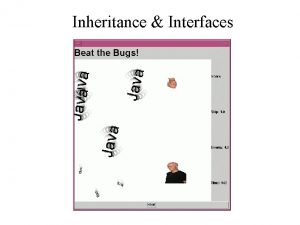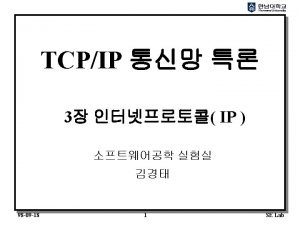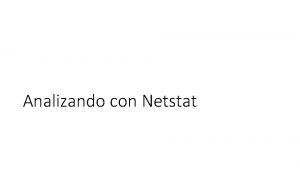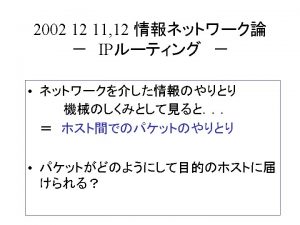Practical Networking Introduction Interfaces network connections Netstat tool






![Demo 1 – Basic Run § Syntax: tcpdump -n -i eth 1 [filter expression] Demo 1 – Basic Run § Syntax: tcpdump -n -i eth 1 [filter expression]](https://slidetodoc.com/presentation_image_h2/8b3c7aa4f03d43d05d7d7513497ca06c/image-7.jpg)












- Slides: 19

Practical Networking

Introduction § Interfaces, network connections § Netstat tool § Tcpdump: Popular network debugging tool § Used to intercept and display packets transmitted/received on a network § Filters used to restrict analysis to packets of interest

Network Interfaces § Linux box: § Show interfaces by “ifconfig” § Look at routing table by running “netstat -r” § IP addresses are 32 bits § Network number, IP within the network § Next hop determined by longest prefix match on the IP address

TCPDUMP § Tool for examining packets on the ethernet/wireless mediums § Need superuser access on machine § Allows you to examine packets -- all of them! § Too much data, so you can employ filters § Simplest case: just specify interface to snoop on

Example Dump Ran tcpdump on the machine danakil-1. dyn § First few lines of the output: § § § 00: 03: 22. 217560 IP c-24 -18 -47 -181. hsd 1. wa. comcast. net. 49735 > danakil-1. dyn. cs. washington. edu. ssh: . ack 67008 win 65535 <nop, timestamp 1998816243 115836780> 00: 03: 22. 222370 IP c-24 -18 -47 -181. hsd 1. wa. comcast. net. 49735 > danakil-1. dyn. cs. washington. edu. ssh: P 49: 97(48) ack 67008 win 65535 <nop, timestamp 1998816243 115836780> 00: 03: 22. 222430 IP c-24 -18 -47 -181. hsd 1. wa. comcast. net. 49735 > danakil-1. dyn. cs. washington. edu. ssh: . ack 67888 win 65535 <nop, timestamp 1998816243 115836783> 00: 03: 22. 222450 IP danakil-1. dyn. cs. washington. edu. ssh > c-24 -18 -47 -181. hsd 1. wa. comcast. net. 49735: P 68720: 69152(432) ack 97 win 3584 <nop, timestamp 115836785 1998816243> 00: 03: 22. 222720 IP danakil-1. dyn. cs. washington. edu. ssh > c-24 -18 -47 -181. hsd 1. wa. comcast. net. 49735: P 69152: 69712(560) ack 97 win 3584 <nop, timestamp 115836785 1998816243>

What does a line convey? Timestamp This Source is an IPhost packet name Source port number (22) 01: 46: 28. 808262 IP danakil. cs. washington. edu. ssh > adsl-69 -228 -230 -7. dsl. pltn 13. pacbell. net. 2481: . 2513546054: 2513547434(1380) ack 1268355216 win 12816 Destination host name Destination port number TCP specific information § Different output formats for different packet types
![Demo 1 Basic Run Syntax tcpdump n i eth 1 filter expression Demo 1 – Basic Run § Syntax: tcpdump -n -i eth 1 [filter expression]](https://slidetodoc.com/presentation_image_h2/8b3c7aa4f03d43d05d7d7513497ca06c/image-7.jpg)
Demo 1 – Basic Run § Syntax: tcpdump -n -i eth 1 [filter expression]

Filters We are often not interested in all packets flowing through the network § Use filters to capture only packets of interest to us §

Demo 2 Capture only udp packets • tcpdump “udp” 2. Capture only tcp packets • tcpdump “tcp” 1.

Demo 2 (contd. ) 1. 2. 3. Capture only UDP packets with destination port 53 (DNS requests) • tcpdump “udp dst port 53” Capture only UDP packets with source port 53 (DNS replies) • tcpdump “udp src port 53” Capture only UDP packets with source or destination port 53 (DNS requests and replies) • tcpdump “udp port 53”

Demo 2 (contd. ) Capture only packets destined to barb. cs. washington. edu • tcpdump “dst host barb. cs. washington. edu” 2. Capture both DNS packets and TCP packets to/from barb. cs. washington. edu • tcpdump “(tcp and host barb. cs. washington. edu) or udp port 53” 1.

How to write filters Refer cheat sheet slides at the end of this presentation § Refer the tcpdump man page §

Other tools § Ethereal § Easy to use graphical interface § http: //www. ethereal. com § IPsumdump § Summarize tcpdump output into human/machine readable form § http: //www. cs. ucla. edu/~kohler/ipsumdump/ § For instructions to use IPsumdump on EECS instructional accounts, see slide “Appendix: IPsumdump on EECS instructional accounts”

Security/Privacy Issues § § § tcpdump allows you to monitor other people’s traffic WARNING: Do NOT use tcpdump to violate privacy or security Use filtering to restrict packet analysis to only the traffic associated with your program. The following is one way to ensure that you see only traffic associated with your client: § tcpdump –s 0 –r all_pkts. trace “ –w my_pkts. trace “port 12345” § where 12345 is the ephemeral port which your echo_client uses to talk to the echo_server.

Cheat Sheet – Commonly Used Options § -n Don’t convert host addresses to names. Avoids DNS lookups. It can save you time. § -w <filename> Write the raw packets to the specified file instead of parsing and printing them out. Useful for saving a packet capture session and running multiple filters against it later § -r <filename> Read packets from the specified file instead of live capture. The file should have been created with –w option § -q Quiet output. Prints less information per output line

Cheat Sheet – Commonly Used Options (contd. ) § -s 0 tcpdump usually does not analyze and store the entire packet. This option ensures that the entire packet is stored analyzed. NOTE: You must use this option while generating the traces for your assignments. § -A (or –X in some versions) Print each packet in ASCII. Useful when capturing web pages. NOTE: The contents of the packet before the payload (for example, IP and TCP headers) often contain unprintable ASCII characters which will cause the initial part of each packet to look like rubbish

Cheat Sheet – Writing Filters (1) Specifying the hosts we are interested in § “dst host <name/IP>” § “src host <name/IP>” § “host <name/IP>” (either source or destination is name/IP) § Specifying the ports we are interested in § “dst port <number>” § “src port <number>” § “port <number>” § Makes sense only for TCP and UDP packets §

Cheat Sheet – Writing Filters (2) Specifying ICMP packets § “icmp” § Specifying UDP packets § “udp” § Specifying TCP packets § “tcp” §

Cheat Sheet – Writing Filters (2) § Combining filters § § and (&&) or (||) not (!) Example: § All tcp packets which are not from or to host quasar. cs. berkeley. edu tcpdump “tcp and ! host quasar. cs. berkeley. edu” § Lots of examples in the EXAMPLES section of the man page
 Kr5yihtnp1c -site:youtube.com
Kr5yihtnp1c -site:youtube.com Do sprawdzenia statystyk protokołów tcp/ip
Do sprawdzenia statystyk protokołów tcp/ip Netstat tulp
Netstat tulp Software defined networking vs traditional networking
Software defined networking vs traditional networking How to calculate subnets and hosts
How to calculate subnets and hosts Introduction to data communications and networking
Introduction to data communications and networking Introduction of networking
Introduction of networking Savage network ip
Savage network ip Expressive interfaces
Expressive interfaces Characteristics of web interface
Characteristics of web interface Uml interfaces are used to:
Uml interfaces are used to: Office interface vs industrial interface
Office interface vs industrial interface Difference between abstract classes and interfaces
Difference between abstract classes and interfaces Interface and abstract class difference in java
Interface and abstract class difference in java Expressive interfaces
Expressive interfaces Dialogue sequence diagram
Dialogue sequence diagram Blueprint interfaces
Blueprint interfaces Common gui event types and listener interfaces in java
Common gui event types and listener interfaces in java Which is not an objective of designing interfaces?
Which is not an objective of designing interfaces? Property management system interface
Property management system interface
